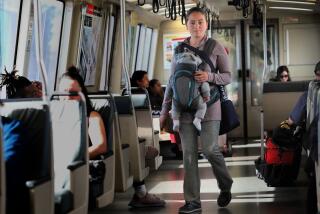Sounds Like Progress : Old Fare Boxes Being Retired as RTD Goes High-Tech
- Share via
After 20 years of greeting millions of Los Angeles-area bus riders, the RTD’s old-fashioned, see-through mechanical fare boxes are being retired.
Gradually, over the next few months, Southern California Rapid Transit District riders will find themselves feeding new, computerized electronic fare takers that go “whir” instead of “clink.”
The new boxes symbolize the passing of an era--the days when you could hop a bus for small change. With fares in many cities approaching or passing $1--the RTD raised its base fare to $1.10 last summer--the volume of dollar bills being handled by transit agencies has increased dramatically, overfilling and jamming the outdated boxes.
“Those old things were coin boxes. They were never intended to take bills,” said Michael Leahy, the RTD’s assistant director of equipment management. “This (new) system is designed to handle paper.”
Sleek Machines
The first 25 buses equipped with the sleek steel-and-plastic units--they gobble dollar bills in one slot like an automatic money changer and take coins in another like a Coke machine--were put on the street Thursday. By February, all 2,600 buses in the fleet are supposed to carry the new boxes.
A 54-day test run of 30 of the machines earlier this year showed that most boarders adapted quickly to the new system, according to RTD officials. But, at least initially, some riders tend to be confused. Used to tightly folding their dollars to get them into the old fare box, they do the same with the new machines--causing the machines to malfunction.
RTD is mounting a “Flat Is Beautiful” public information campaign to coach riders on the best way to feed the machines.
Transit district officials say the advantages of the new systems are considerable--better security for the huge sums of cash collected each day and assurance that complete fares are collected. The driver will glance at a digital display that shows what each boarding passenger has deposited. The fare money, which now often spills out of open cash boxes as it is removed by bus maintenance workers, will be in sealed containers until it reaches an RTD vault. In addition, the new machines will keep a record of what should be in the cash boxes.
Theft of fare box cash has been a problem at the district in the past, and several workers have been arrested. But officials say they do not know how much has been lost.
For whatever reasons, the new generation fare boxes have typically increased transit revenues 2% to 3%, Leahy said. That would be about $4 million to $6 million per year in the RTD’s case.
Santa Monica, Long Beach and other bus lines have used the new systems for years. But they were a long time coming for the RTD. Plagued by performance problems, disputes with the manufacturer, lawsuits and cost increases, the $12.5-million fare box replacement program has come in about 25% over the original price and a year and a half late.
Leahy and Roger Kuite, project manager for the manufacturer of the new fare boxes, San Diego-based Cubic Western Data, said jamming and overloading problems encountered with the fare boxes during early tests have been corrected.
Several RTD drivers in downtown Los Angeles--the area expected to get the new fare boxes first--said Thursday that they had not yet used the new units.
But one who had, nine-year veteran John Lee, was satisfied. “It works better for me. It’s faster. And it cuts down on fraud--that’s the main thing.”
More to Read
Sign up for Essential California
The most important California stories and recommendations in your inbox every morning.
You may occasionally receive promotional content from the Los Angeles Times.










